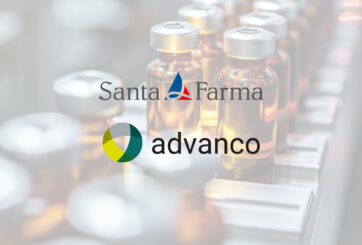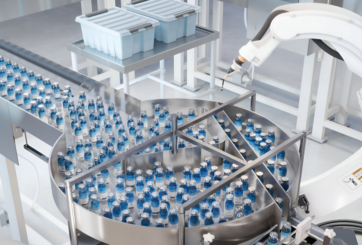How Track and Trace Technology Can Improve Efficiency in the Pharmaceutical Sector – and Stamp Out Its Biggest Threat
In an ever-competitive pharmaceutical sector, and against a backdrop of rising pharmaceutical forgeries, track-and-trace technology is becoming more important than ever before.

You are a key executive within a pharmaceutical business which manufactures life-saving medication which is shipped right across the globe.
You have three important objectives for your business. The first is to streamline operations while saving money. The second is to step up your firm’s environmental and social governance (ESG) efforts, something which is rapidly becoming a must-have rather than a nice-to-have on the corporate radar of any business. The third is to be fully compliant with local regulations.
Would you be interested in learning how the adoption of a single business practice could address these ambitions? I would argue that, certainly, most of us would.
In an ever-competitive pharmaceutical sector, and against a backdrop of rising pharmaceutical forgeries, track-and-trace technology is becoming more important than ever before. It provides the sophisticated technology that will take full advantage of Industry 4.0. and the technological revolution this is already driving. It also plays a critical role in ensuring consumers have the confidence that the drugs being produced by pharmaceutical manufacturers are the real-deal, and won’t result in dangerous side effects, or even death.
More companies than ever are realizing for themselves the importance of track and trace solutions. Indeed, the global market is estimated to reach an expected value of USD 14.3 Billion by 2030, growing at a CAGR of 19.30% during the forecast period (2022–2030) according to forecasts by Straits Research.
Operational efficiency
As with all business sectors, pharmaceutical firms are on a constant quest to streamline their operations and increase efficiency. Never has this been so important as the present time. Indeed, the advent of Industry 4.0. is presenting a golden opportunity to completely overhaul current, often antiquated systems, that are preventing pharmaceutical businesses from performing at their optimum output level.
Industry 4.0. is already revolutionizing the way the pharmaceutical sector works. Once only possible for international blue-chip corporations, robotics are becoming much more affordable and available to organizations of every size. From picking products at a warehouse to getting them ready to ship, autonomous robots can quickly and safely support manufacturers. Likewise, we will see distribution centres that will use autonomous cranes and trucks to streamline operations as they accept shipping containers from the ships.
A combination of cyber-physical systems, the Internet of Things and the Internet of Systems will power Industry 4.0 and allow the smart factory to become a reality. As a result of the support of smart machines that keep getting smarter as they get access to more data, the global pharmaceutical sector will become more efficient and productive and less wasteful.
This is where a watertight track and trace system will really shine. It links together the essential components that modern pharmaceutical businesses need to thrive. These components include operational shopfloor efficiency, greater warehouse automation, generating more data which will further optimize the supply chain, and creating customer engagement through product identification.
Overhauling systems to increase efficiency
The traditional business computing set-up is built on a centralized data center. However, the global pandemic vaccine roll-out has magnified the fact that the everyday internet isn’t well suited to moving endlessly growing rivers of real-world pharmaceutical track-and-trace data. Indeed, the ever-present threats resulting from bandwidth limitations, latency issues and unpredictable network disruptions have threatened to cause major operational issues to those tasked with ensuring a watertight vaccine rollout to all four corners of the globe.
The prospect of moving so much data in situations that can often be time- or disruption-sensitive puts incredible strain on the global internet, which itself is often subject to congestion and disruption.
The move to edge computing
Edge computing is a distributed IT architecture in which client data is processed at the periphery of the network, as close to the originating source as possible.
It shifts the focus from the central data center to the logical edge of the infrastructure — taking storage and computing resources from the data center and moving those resources to the point where the data is generated.
The principle is straightforward: If you can’t get the data closer to the data center, get the data center closer to the data.
Processing often involves normalizing and analyzing the data stream to look for business intelligence, and only the results of the analysis are sent back to the principal data center.
The impact of edge computing on warehouse operations
The impact of this new-edge technology on the pharmaceutical track-and-trace sector will be huge, especially where overall supply-chain operations are concerned.
We have seen a move towards a much more agile, local supply chain. The rapid uptake of digital barcode scanning systems combined with the very latest, cutting-edge technology, has made supply chains much more secure.
New-edge computing will tighten this up even further. It will power automatic, time-sensitive supply chain processes in warehouses, factories, and manufacturing facilities. These processes will lessen the need for human management and create optimal outcomes while eliminating the risk of error due to manual processes.
One way that edge computing will drive the process will see the addition of a scanner with a mobile application supporting the handling of serialized products across the supply chain and within warehouse operations. It will run on commercially available devices deployed at the warehouse, packaging, and other operational facilities.
The product will provide complete visibility across the global supply chain. This, combined with the ability to connect with multiple Enterprise-Level (Level 4) serialization repositories, Warehouse Management Systems (WMS), and Enterprise Resource Planning (ERP) solutions, will complement the valuable investments made within existing solutions.
Furthermore, new-edge technology will sit behind the rise of smart robots that are poised to transform warehouse operations even further.
Indeed, Gartner predicts that 75% of large enterprises will have adopted some form of smart robots in their warehouse operations by 2026 as they search for flexible automation.
The ongoing battle against the pharmaceutical forgers
I have, so far, hopefully presented a brief overview of how track and trace technology can drive operational efficiency in the coming years. Let’s now look at how it can play a key role in fighting against the forgers who risk millions of lives daily.
All of us who work in the pharmaceutical sector are profoundly aware of the ever-present, and ever-dangerous issue of counterfeit drugs.
It is predicted that 10% of pharma products worldwide are counterfeit, with the global counterfeit drug market exceeding an eye-watering $75bn. Research further estimates that the death-toll caused as a result could increase to 10 million people by 2050.
Estimates by the World Health Organization show that between 72 000 and 169 000 children may die from pneumonia every year after receiving counterfeit drugs, and that fake anti-malarial medication might be responsible for an additional 116 000 deaths.
Studies show about 9%-41% of medicines sold in low- and middle- income countries are counterfeit. In contrast, in high-income countries, such as the United States, less than 1% of medicines sold are counterfeit.
It is incredibly hard to spot forgeries. The only real way to know if a drug is counterfeit is through chemical analysis done in a laboratory. Sometimes, counterfeit drugs differ in size, shape, or colour, or are sold in poor-quality packaging, but they often appear identical to the real thing, which makes them especially dangerous.
I have long argued that stricter enforcement, opening the supply chain, improving ESG efforts and implementing much tighter industry standards are key in the ongoing battle against medicine forgers.
The implementation of open standards is another crucial method in the fight against fake Covid vaccines and other drugs. The establishment of OPEN-SCS, the industry body responsible for promoting common standards across the pharma sector, is another a solid step forward in the fight against fake medicines.
The fact is that serialization track and trace technology, which allows the provenance of a drug to be tracked right from production to the shop floor, is crucial in providing the assurance that consumers need to trust the medicines they are using.
It also provides a key ESG objective by adhering to the 2030 Agenda for Sustainable Development, adopted by all United Nations Member States in 2015, which provides a shared blueprint for peace and prosperity for people and the planet, now and into the future. Track and trace systems directly help companies meet Sustainable Development Goal (SDG) 3: Good Health and Wellbeing, by allowing access to genuine, safe, quality, and affordable medicines and vaccines for all.
Conclusion
Track and trace technology is becoming increasingly high on the agenda for multiple companies. For those that need to learn more, I would argue that now is the time to act upon this.
With Industry 4.0. presenting a golden opportunity for systems to be overhauled, and with the challenges of fake medicine being ever-present as an issue we must all address, track and trace systems will soon be in demand more than ever before – as evidenced by the rapid growth expected for the sector in the coming years.



